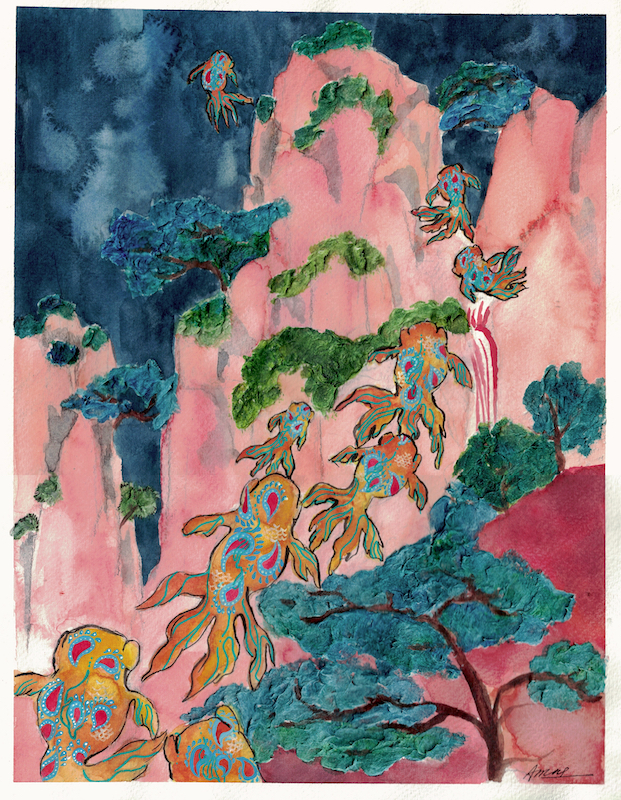Illustrations made in Circles for Reconciliation sessions
The grassroots group Circles for Reconciliation was initially inspired by a line from the Truth and Reconciliation Commission’s interim report in 2015 – “there is no reason for anyone who wants to contribute to the reconciliation process to wait until the publication of the Commission’s final reports.”
Founder Raymond Currie consulted with various Indigenous groups and Elders before launching the first free circle in Manitoba with an equal mix of Indigenous and non-Indigenous participants. While the pandemic has forced this popular project to go online, it has also created new opportunities for expanding its reach across the country.
After Montreal college student Anne Lin Arghirescu completed the program last fall, she realized it would be an effective way to foster understanding between students at Marianopolis College. With the help of Indigenous friend Karonhianó:ron Curotte, she began organizing circles over Zoom. They now include students across the Montreal area.
“I’ve been exploring the Indigenous cause from a young age through storytelling, visiting exhibitions and personal research,” Arghirescu told the Nation. “When I started college, I realized there was a lack of framework to welcome Indigenous students. I discovered the Circles for Reconciliation non-profit and thought that would be a great way to bring people together.”
As the daughter of Eastern European and Asian immigrants, the struggles of Indigenous peoples resonated with the contradictory worldviews of Arghirescu’s mixed heritage. In a Reconciliation promotional booklet recently published by Marianopolis, Arghirescu discusses clinging to a Canadian identity and feeling alienated from her family.
“I’ve had to do this mediating between cultures,” shared Arghirescu. “For Indigenous peoples, to be at once excluded from Canadian society and forcefully assimilated throughout history is something I feel close to. Learning about all the positive aspects that exist in modern Indigenous culture through the circle discussions is very inspiring.”
Arghirescu believes the program’s formula of pairing five Indigenous people with five non-Indigenous people in weekly 90-minute meetings over 10 weeks helps develop interpersonal relationships that become more intimate as the participants get more comfortable. Conversations led by one Indigenous and one non-Indigenous facilitator are guided by a different theme each week.
“We do a reading together at the beginning of the circle and then we share our impressions about stories that relate to the topic we’re discussing,” explained Arghirescu. “There’s just enough structure to flow well but it also leaves a lot of space for the personal stories of each participant. It’s getting to know people below the surface, what they’re willing to share.”
For students coping with the isolation of online studies, these sessions have been therapeutic. Many non-Indigenous participants say they’re motivated to share what they’ve learned, helping to debunk stubborn myths in mainstream culture.
“I’ve received a lot of feedback from non-Indigenous participants realizing how incomplete and flawed history teachings are in Canada,” Arghirescu said. “Everything’s a bit detached from the present. Circles for Reconciliation help make that link – Indigenous communities are in a process of ongoing growth and transformation while remaining true to their traditions.”
With interest also growing in teaching faculty and staff, Arghirescu is hoping to recruit more Indigenous participants for circles to begin in late March or early April. While the benefits of joining these circles may be less apparent for Indigenous people, Arghirescu emphasized that there is no pressure to represent one’s culture.
“Reconciliation can be difficult to talk about, but because the circles focus on equal representation, it’s not like all the weight is placed on a few Indigenous participants to educate a whole room,” Arghirescu said. “It’s a more informal dynamic of talking about personal experiences. It’s a nice place to form friendships through stories.”

Crees who may be interested in the program should know that it doesn’t matter how connected one is to their Indigenous identity. Anyone with an internet connection and a willingness to develop respectful relationships is invited. Many Indigenous participants have enjoyed learning cultural practices and stories of resilience from other First Nations across Canada.
Curotte felt that by bonding over environmental issues, the non-Indigenous participants began to understand common frustrations of First Nations peoples.
“It was an opportunity for me to speak to people who were willing and eager to listen,” Curotte commented in the booklet. “By telling other students about stories and events of the Kanien’keha:ka peoples close to Montreal, I believe I was able to impact their worldviews. Circles like ours can be a stepping stone towards real change.”
While Arghirescu hopes to eventually organize future sessions in-person, there are distinct advantages of maintaining Circles for Reconciliation online. The convenience of sharing stories with others over long distances make Zoom a useful platform, especially for connecting with participants from remote communities.
“I really like the dynamic of these national circles where there’s the opportunity for people from all over Canada to participate,” said Arghirescu. “The pace is quickening, there are more and more people who are interested now that the news is getting out. We even have Indigenous people from Central America – it’s great to have so many perspectives.”
To register for the student circle: https://forms.gle/UbhkQymrkSKdST9w6
To register for the faculty and staff circle: https://forms.gle/WTh63JCekY2FASAb6





